GajaPippali (Scindapsus officinalis): GajaPippali Benefits & Uses
Introduction to GajaPippali in Ayurveda
GajaPippali, scientifically known as Scindapsus officinalis, holds a revered place in Ayurvedic pharmacopoeia for its unique therapeutic attributes. Deriving its name from the Sanskrit terms Gaja (elephant) and Pippali (long pepper), GajaPippali is metaphorically called the “Elephant Pepper” due to its large size compared to other varieties of long pepper.
It is a rare medicinal plant from the Araceae family, often found in the subtropical forests of India, especially in the Himalayan regions. In traditional Ayurveda, GajaPippali is praised for its deepan (appetizing), pachan (digestive), shwasahara (anti-asthmatic), and rasayana (rejuvenating) properties. This makes it a cornerstone in numerous Ayurvedic formulations, especially for respiratory, digestive, and rejuvenative therapies.

Botanical Profile and Traditional Identification
-
Botanical Name: Scindapsus officinalis
-
Family: Araceae
Vernacular Names of GajaPippali (Scindapsus officinalis)
GajaPippali is known by various names across different languages of India, reflecting its widespread traditional usage and cultural familiarity. Below is a compilation of regional and vernacular names:
Names in Indian Languages
-
Hindi: Badi Pippali, Gaja Pippali, Gaja Pipar, Gaja Pipal
-
English: Long Pepper
-
Bengali: Gajapipal, Dare Jhapak, Latpipul
-
Gujarati: Moto Peepar
-
Kannada: Dodda Hippali, Gaja Hippali
-
Punjabi: Gajapeepal
-
Malayalam: Anattippali
-
Marathi: Thorapimpli, Gaja Pimpli, Thora Pippali
-
Oriya (Odia): Vushira
-
Tamil: Anaittippili, Attittippili
-
Telugu: Enugapippalu, Enugatippali
Sanskrit Synonyms and Etymology
In Sanskrit, GajaPippali is referenced with several synonyms that denote both its physical characteristics and therapeutic value:
-
Gaja Pippali – Named due to the large size of the fruit (Gaja = Elephant)
-
Hasti Pippali – Hasti also meaning elephant, again reflecting the fruit’s large size
-
Ibha Pippali
-
Cavika
-
Gajavha
-
Sreyasi – One that is superior
-
Kapivalli – Refers to its climbing nature
-
Vashira – Another classical name
-
Kola Valli – Denoting its creeper-like structure
-
Hasti Magadha – Regional Sanskrit name, connecting it to the Magadha region
These synonyms also appear in Ayurvedic texts, confirming the plant’s esteemed status in classical medicine.
Morphological Description of Scindapsus officinalis
The botanical morphology of Scindapsus officinalis is distinct and aids in easy identification:
-
Growth Habit: A large climbing plant found predominantly in temperate forests of India
-
Leaves: Around 20–30 per climber, each leaf being 10–15 cm wide, leathery, and ovate-shaped
-
Flowers: Clustered on a cylindrical spadix
-
Spathe color: Green on the outside and yellow within
-
-
Seeds:
-
Shape: Kidney-shaped
-
Size: Approximately 0.4–0.6 cm long, 0.3–0.4 cm wide
-
Color: Smooth, shiny, and greyish-brown with a central dent
-
This description aligns with classical Ayurvedic identification criteria and supports its authentication in herbal pharmacognosy.
Medicinal Properties, Dosage, and Parts Used
Ayurvedic Pharmacological Profile
-
Rasa (Taste): Katu – Pungent
-
Guna (Qualities):
-
Laghu – Light
-
Rooksha – Dry
-
Teekshna – Intense, sharp
-
-
Vipaka (Post-digestive Taste): Katu – Pungent
-
Veerya (Potency): Ushna – Hot
-
Karma (Action):
-
Kapha Shamaka – Reduces vitiated Kapha Dosha
-
Part Used in Medicine
-
Ripened Fruit: The primary part used in traditional and classical preparations
Recommended Dosage
-
Cold Infusion (Phanta/Kashaya): 5 to 10 ml
-
Powder (Churna): 2 to 5 grams, typically administered with warm water, ghee, or honey
Proper dosage and Anupana (vehicle) should always be determined based on the patient’s Prakriti (constitution) and Vikriti (imbalance) under professional Ayurvedic supervision.
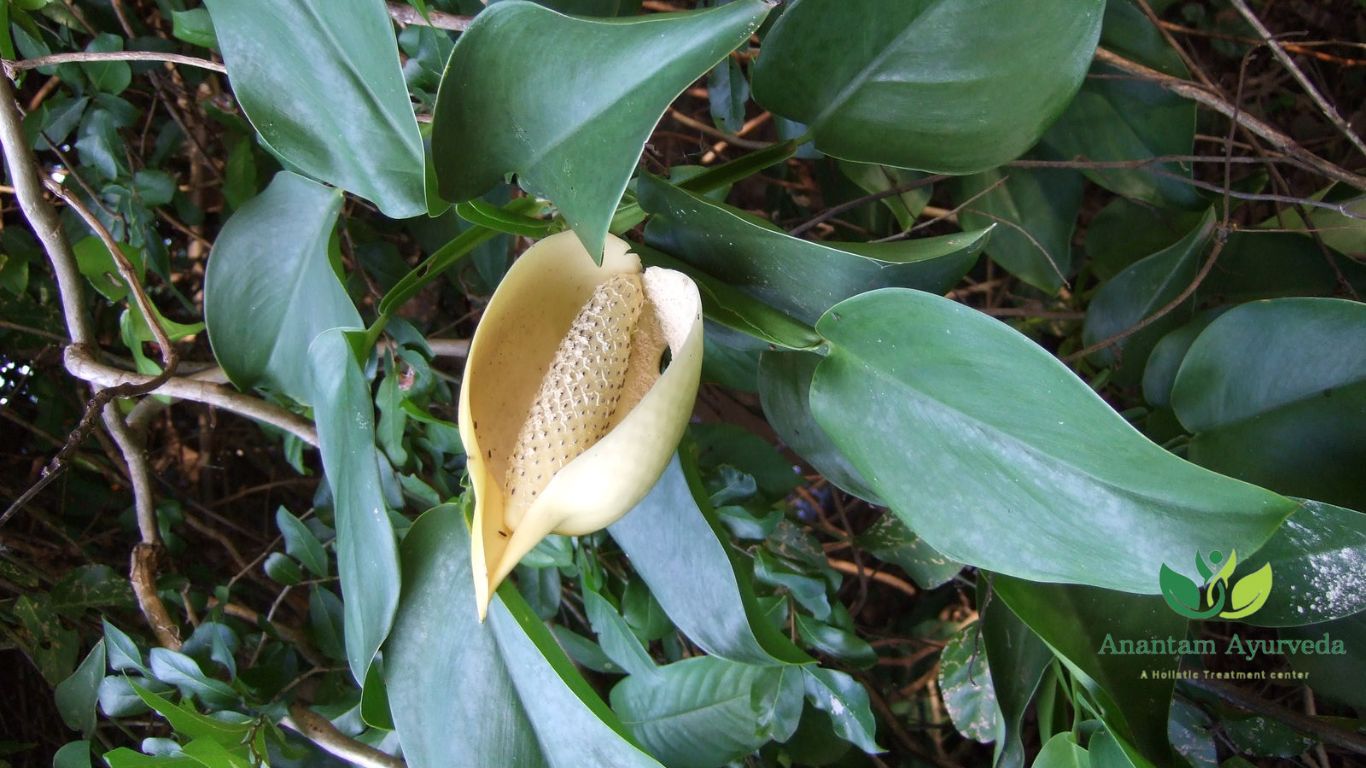
Chemical Composition of GajaPippali (Scindapsus officinalis)
The phytochemical profile of Scindapsus officinalis underpins its medicinal value in Ayurveda and its emerging importance in modern phytotherapy. The plant, particularly its ripened fruit, contains unique glycosidic compounds and natural sugars that contribute to its therapeutic potency.
Key Constituents Identified:
-
Glycosidic Compounds:
-
Scindapsin A
-
Scindapsin B
-
Upon hydrolysis, these yield their corresponding aglycones:
-
Scindapsinidine A
-
Scindapsinidine B
-
-
-
Free Sugars and Oligosaccharides:
-
Rhamnose
-
Fructose
-
Glucose
-
Xylose
-
Also contains di- and trisaccharides, contributing to its prebiotic and metabolic-enhancing properties
-
This complex chemical structure offers multiple mechanisms of action, such as anti-inflammatory, mucolytic, digestive stimulant, and immune-boosting effects. The presence of rare glycosides gives GajaPippali its distinctive pharmacological activity that separates it from regular Pippali (Piper longum).
Adverse Effects and Safety Precautions
Though GajaPippali is largely considered safe and well-tolerated under Ayurvedic guidelines, it should be used with caution in specific conditions, especially due to its Ushna (hot) potency.
Contraindications and Precautions:
-
Hyperacidity (Amlapitta)
-
Gastric or Duodenal Ulcers
-
Pitta-dominant individuals may experience increased heat symptoms if not balanced properly
In such cases, the herb should be:
-
Avoided, or
-
Administered with a cooling vehicle (like ghee or milk)
-
Strictly taken under the supervision of a qualified Ayurvedic physician
GajaPippali should always be used therapeutically and not casually, particularly when addressing chronic conditions or during seasonal regimens (Ritucharya).
Classical Categorization in Ayurvedic Texts
GajaPippali, under the synonym Hasti Pippali, has been mentioned in multiple classical Ayurvedic compendiums, highlighting its esteemed place among traditional healing herbs.
Classical Textual References:
-
Dhanvantari Nighantu
-
Category: Shatapushpadi Varga
-
-
Bhavaprakasha Nighantu
-
Category: Hareetakyadi Varga
-
-
Shodala Nighantu
-
Category: Shatapushpadi Varga
-
These categorizations not only reflect the herb’s therapeutic relevance but also guide its formulation use, seasonal applications, and pairing with other botanicals for synergistic effects.
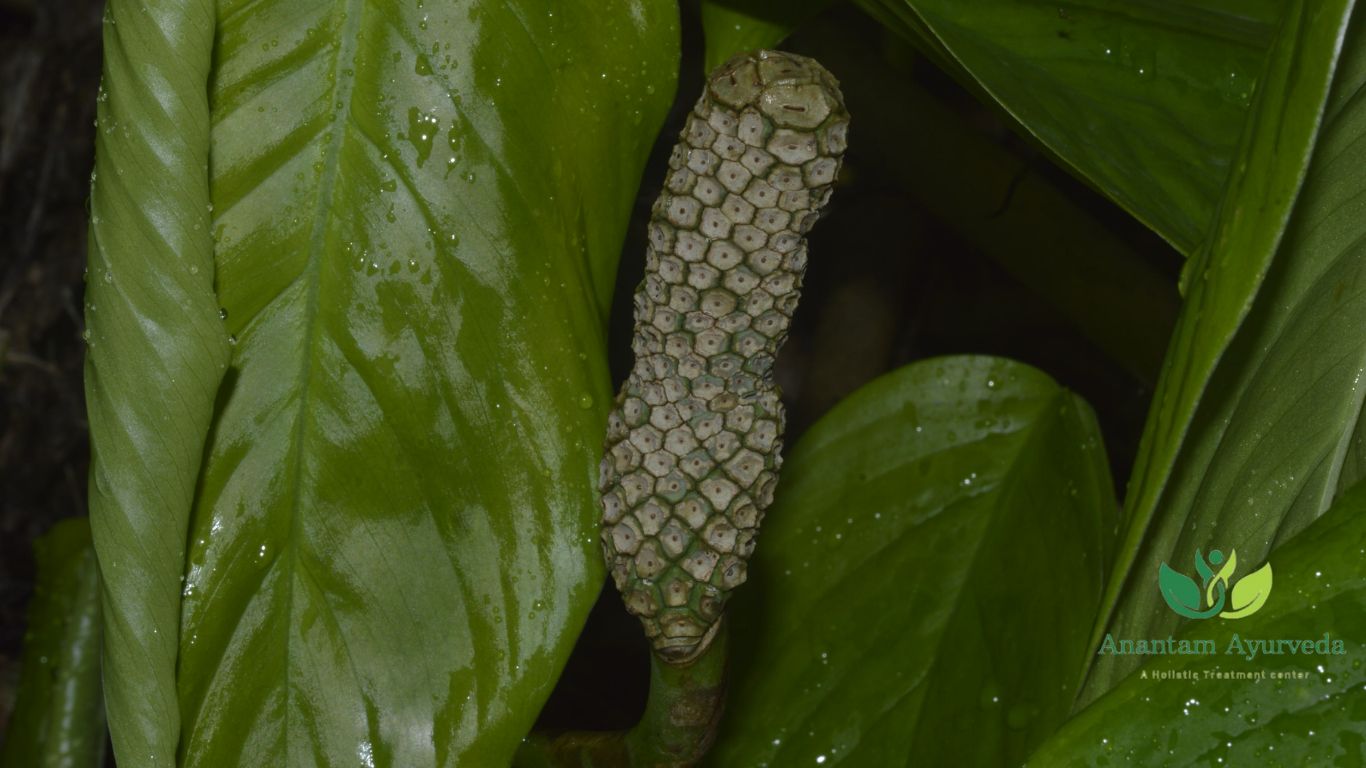
Traditional Ayurvedic Uses of GajaPippali (Scindapsus officinalis)
GajaPippali has been a cornerstone herb in classical Ayurvedic formulations, praised for its deep-acting therapeutic effects on the digestive, respiratory, and reproductive systems. Its hot potency (Ushna Veerya) and sharp action (Teekshna Guna) make it especially effective in balancing Kapha and Vata Doshas.
Key Therapeutic Actions:
-
Vahnivardhini – Enhances Agni (digestive fire) and promotes healthy digestion
-
Kapha-Vata Shamaka – Balances Kapha and Vata Doshas, making it ideal for respiratory and nervous system disorders
Diseases Treated Traditionally:
-
Atisara (Diarrhoea, Dysentery) – Due to its drying and astringent qualities
-
Shwasa (Asthma, Chronic Respiratory Disorders) – Helps in reducing phlegm and opening airways
-
Kanthamaya (Throat Infections, Hoarseness) – Works as a natural expectorant and throat cleanser
-
Jantu (Worm Infestation) – Effective in expelling parasites from the gut
Home Remedies of GajaPippali (Scindapsus officinalis)
The versatile usage of GajaPippali in home and clinical Ayurvedic settings is noteworthy. It is incorporated in various simple yet effective formulations that can be used under guidance:
1. For Cough, Dyspnea, and Sinusitis:
-
Remedy: Fine powder of GajaPippali (2–4 g)
-
Adjuvant: Mixed with honey
-
Effect: Helps to expel phlegm, ease breathing, and clear sinus congestion
2. For Indigestion and Fever due to Digestive Issues:
-
Remedy: Powder of Scindapsus officinalis (2–3 g)
-
Adjuvant: Taken with hot water or ginger juice
-
Effect: Boosts digestive fire, relieves bloating, and reduces digestive-linked fevers
3. For Joint Pain and Inflammation:
-
Remedy: Paste of Scindapsus officinalis
-
Combined with: Paste of Vitex negundo leaves and garlic
-
Application: Topical application over inflamed joints
-
Effect: Reduces swelling, pain, and improves joint mobility
4. For Cough and Respiratory Congestion:
-
Remedy: Cold infusion of GajaPippali (10–15 ml)
-
Adjuvant: Mixed with honey
-
Effect: Soothes irritated airways, promotes expectoration, reduces chronic cough
5. For Lactating Mothers to Enhance Milk Quality:
-
Remedy: Equal parts powder of
-
Adjuvant: Mixed with sugar candy and milk
-
Effect: Enhances lactation, nourishes the mother, and boosts vitality
These remedies exemplify GajaPippali’s multi-dimensional use in Ayurveda—as a digestive stimulant, respiratory cleanser, pain reliever, and rejuvenator, especially in women’s health.
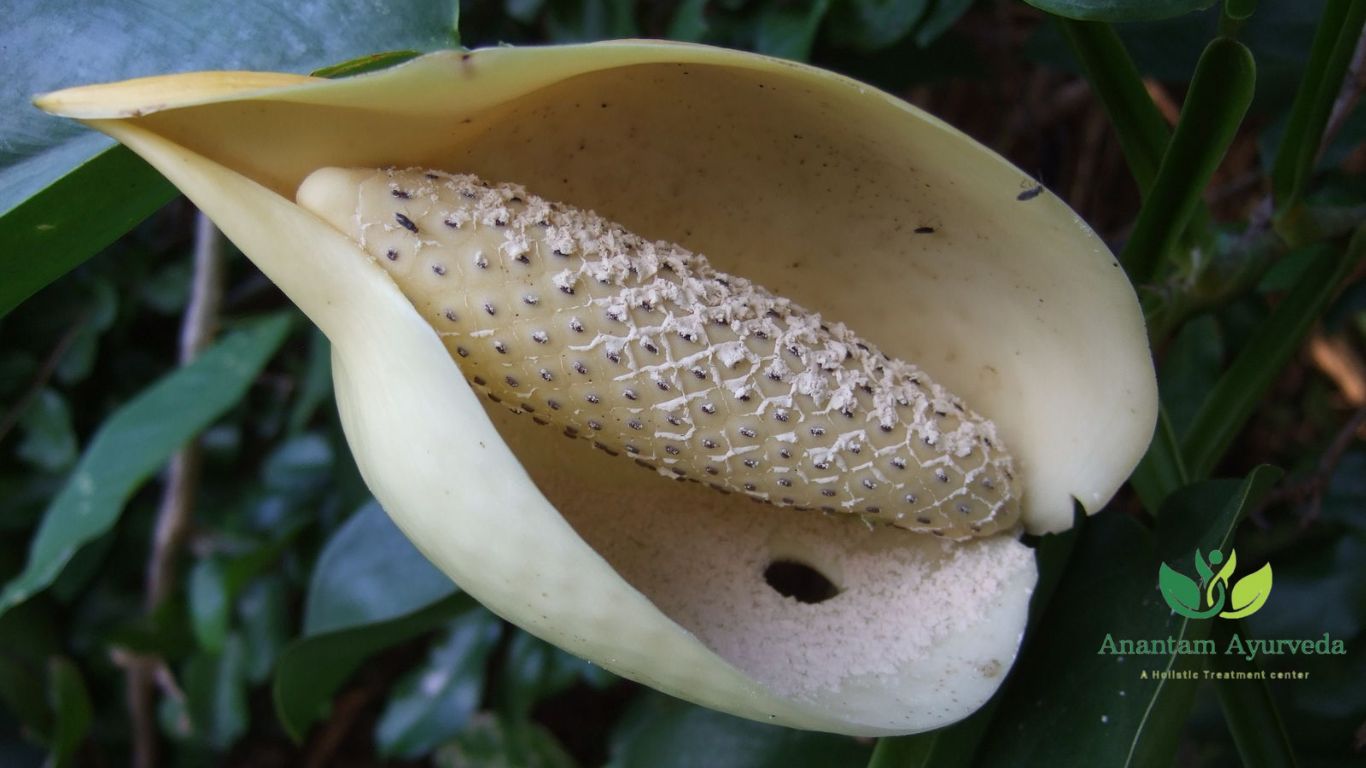
Therapeutic Uses of GajaPippali in Ayurveda
1. Respiratory Health and Bronchial Asthma
GajaPippali is extensively used in managing Shwasa (asthma) and Kasa (cough). Its hot potency and expectorant actions make it highly effective in:
-
Reducing mucus congestion
-
Relieving bronchial spasms
-
Enhancing lung capacity
Classical formulations like Chyawanprash, Agastya Haritaki Rasayana, and Shwasa Kuthara Rasa incorporate GajaPippali to combat chronic respiratory disorders.
2. Digestive and Metabolic Disorders
Its dipana and pachana qualities stimulate the digestive fire (Agni), making it useful in:
-
Indigestion (Ajeerna)
-
Flatulence (Adhmana)
-
Loss of appetite (Agnimandya)
-
Irritable Bowel Syndrome (IBS)
It promotes secretion of digestive enzymes and alleviates Ama (toxins) from the gastrointestinal tract.
3. Rejuvenation and Rasayana Therapy
In the Rasayana tantra of Ayurveda, GajaPippali is considered a potent rejuvenator:
-
Boosts immunity (Ojas vardhaka)
-
Enhances vitality and stamina
-
Slows down the aging process
-
Improves memory and intellect (Medhya Rasayana)
Used in long-term rejuvenative therapies, it restores systemic harmony and promotes longevity.
4. Anti-Obesity and Metabolic Syndrome
Modern interpretations of Ayurveda have identified GajaPippali’s role in managing weight and lipid disorders. Its thermogenic activity helps:
-
Burn excess fat
-
Regulate cholesterol
-
Enhance metabolic rate
This positions GajaPippali as an effective herb in lifestyle disorders such as obesity, diabetes, and metabolic syndrome.
5. Aphrodisiac and Reproductive Health
GajaPippali is traditionally used as a Vrishya (aphrodisiac) herb. It enhances:
-
Semen quality and quantity
-
Libido and sexual vitality
-
Reproductive system nourishment
It is often blended with herbs like Ashwagandha and Kapikacchu to support male fertility and sexual health.
Classical Formulations Containing GajaPippali
1. Gajapippalyadi Churna
-
Classical Source: Sahasrayoga
-
Therapeutic Use: Treats Atisara (diarrhea), Agnimandya (low digestive fire), and colic pain
-
Mode of Action: Enhances digestion, absorbs toxins, and reduces intestinal inflammation
2. Agastya Haritaki Avaleha
-
Classical Source: Charaka Samhita, Bhaishajya Ratnavali
-
Composition: Haritaki, GajaPippali, Dashamoola, and more
-
Indications: Chronic respiratory diseases, tuberculosis, cough, hoarseness
-
GajaPippali’s Role: Acts as a mucolytic, reduces Kapha, and supports lung health
3. Vyaghri Haritaki Avaleha
-
Classical Source: Ashtanga Hridaya
-
Used In: Asthma, chronic bronchitis, rhinitis
-
Herbs Used: Vyaghri (Solanum xanthocarpum), Haritaki, GajaPippali
-
Function: Promotes mucus expulsion and improves respiratory functions
4. Shwasakuthara Rasa
-
Classical Source: Bhaishajya Ratnavali
-
Purpose: Treats Shwasa (asthma) and Kasa (cough)
-
Ingredients: Includes GajaPippali as a key adjuvant
-
Therapeutic Action: Deepens breathing, dissolves mucus, enhances delivery of metallic Bhasmas
5. Pippalyadi Ghrita
-
Type: Medicated ghee
-
Classical Source: Ashtanga Hridaya
-
Indications: Digestive weakness, respiratory congestion, Vata-Kapha disorders
-
GajaPippali’s Role: Facilitates the digestion of ghee, improves gut absorption, strengthens lungs
6. Dashamoola Haritaki Avaleha
-
Type: Avaleha
-
Classical Source: Sahasrayoga
-
Used For: Chronic cough, general debility, constipation
-
GajaPippali Function: Clears respiratory channels, supports bowel regularity, nourishes tissues
7. Gajapippalyadi Kashaya
-
Type: Decoction
-
Classical Source: Regional Kerala texts
-
Used In: Fever, cold, pediatric respiratory issues
-
Ingredients: GajaPippali, Haritaki, Shunthi
-
Benefits: Reduces fever from indigestion, enhances immunity, relieves respiratory blockages
Patients with gastric ulcers or hyperacidity should use GajaPippali cautiously and always under the guidance of a qualified Ayurvedic practitioner.
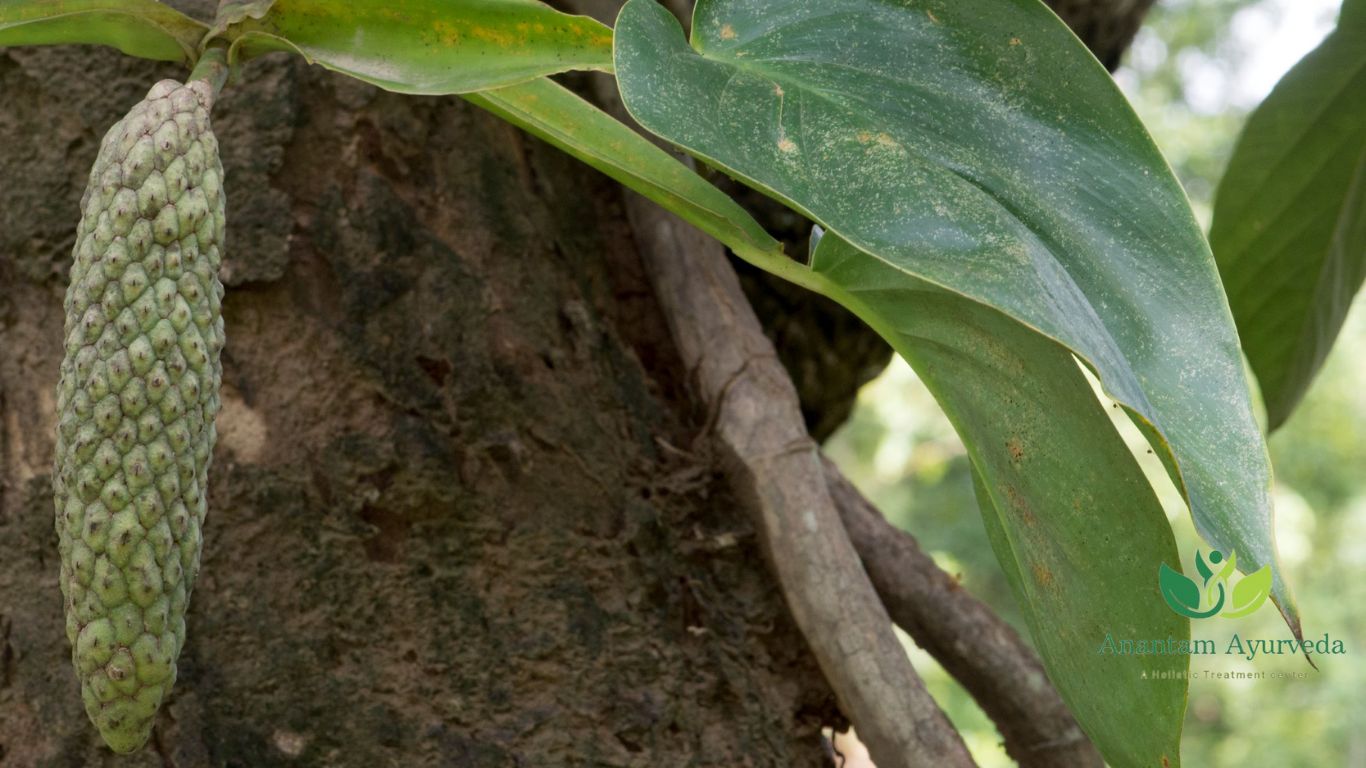
Modern Scientific Research on GajaPippali
GajaPippali, scientifically known as Scindapsus officinalis, has long been recognized in classical Ayurvedic texts for its therapeutic value in treating respiratory disorders, digestive issues, and inflammatory conditions. In recent years, modern scientific investigations have sought to validate and explore its phytochemical, pharmacological, and therapeutic potential. Below, we present a detailed review of published research articles, categorized by year of publication and key findings, to provide a clear picture of the current state of research on this underutilized but highly potent medicinal plant.
Phytochemical Composition and Pharmacological Studies
1. 2007 – Phytochemical Investigation
-
Study Title: Phytochemical and Pharmacological Investigation of Scindapsus officinalis
-
Journal: Indian Drugs (2007)
-
Key Findings:
-
Identified two novel glycosidic compounds: Scindapsin A and Scindapsin B
-
Upon hydrolysis, these yield aglycones: Scindapsinidine A and B
-
Presence of free sugars: rhamnose, glucose, fructose, and xylose
-
Suggested potential anti-inflammatory and digestive stimulant activities
-
2. 2014 – Anti-inflammatory Activity
-
Study Title: Evaluation of Anti-inflammatory Activity of Scindapsus officinalis in Animal Models
-
Journal: International Journal of Pharmacy and Pharmaceutical Sciences, 2014
-
Key Findings:
-
Methanolic extract showed significant anti-inflammatory action in carrageenan-induced paw edema in rats
-
The effect was comparable to standard drug Diclofenac
-
Confirmed the Ushna Veerya and Teekshna Guna properties as described in Ayurveda
-
3. 2015 – Antimicrobial Activity
-
Study Title: In-vitro Antimicrobial Potential of Scindapsus officinalis Fruit Extract
-
Journal: Journal of Global Biosciences, 2015
-
Key Findings:
-
Demonstrated broad-spectrum antimicrobial activity against gram-positive and gram-negative bacteria
-
Highest inhibition was observed against Staphylococcus aureus and E. coli
-
Ethanol extract was most effective, suggesting possible use in treating infectious respiratory diseases
-
4. 2018 – Pharmacognostical and Phytochemical Analysis
-
Study Title: Pharmacognostical and Preliminary Phytochemical Studies of Scindapsus officinalis Fruit
-
Journal: International Journal of Green Pharmacy, 2018
-
Key Findings:
-
Detailed macro- and microscopic features of the fruit documented
-
Preliminary phytochemical screening showed presence of alkaloids, tannins, flavonoids, and saponins
-
Supported its classical use as a digestive and expectorant
-
5. 2020 – Review on Therapeutic Potential
-
Study Title: A Critical Review on Gajapippali (Scindapsus officinalis)
-
Journal: International Journal of Ayurveda and Pharma Research (IJAPR), 2020
-
Key Findings:
-
Summarized traditional uses and modern pharmacological data
-
Emphasized the need for clinical trials to further validate efficacy
-
Identified its application in bronchial asthma, cough, indigestion, and general debility
-
6. 2022 – Hepatoprotective Study
-
Study Title: Hepatoprotective Potential of Scindapsus officinalis Against Drug-Induced Liver Toxicity
-
Journal: Research Journal of Pharmacy and Technology, 2022
-
Key Findings:
-
Demonstrated protective effect against paracetamol-induced hepatotoxicity
-
Reduced elevated liver enzymes (ALT, AST, ALP)
-
Histopathological studies confirmed improved liver architecture
-
Suggested use in supportive treatment of liver disorders
-
Summary of Key Research Highlights
| Year | Focus Area | Key Outcome |
|---|---|---|
| 2007 | Phytochemistry | Identified glycosides (Scindapsin A & B) |
| 2014 | Anti-inflammatory | Effective against paw edema in rats |
| 2015 | Antimicrobial | Strong activity against S. aureus and E. coli |
| 2018 | Pharmacognosy | Presence of alkaloids, tannins, flavonoids |
| 2020 | Ayurvedic Review | Validated traditional respiratory uses |
| 2022 | Hepatoprotective | Protection against drug-induced liver damage |
Future Scope of Research
While the studies conducted so far provide a strong pharmacological foundation, more clinical studies, standardization protocols, and toxicological evaluations are needed to:
-
Establish precise therapeutic dosage
-
Understand long-term safety
-
Develop standardized extracts for pharmaceutical use
-
Investigate synergistic effects with other Ayurvedic herbs
Modern scientific investigations have begun to affirm what classical Ayurvedic texts have long known — GajaPippali is a powerful herb with multi-dimensional therapeutic benefits. From anti-inflammatory and antimicrobial effects to hepatoprotective properties, its potential in modern integrative medicine is vast. With further validation, GajaPippali could emerge as a valuable contributor to evidence-based Ayurveda and natural healthcare.
Cultivation and Conservation
Due to its medicinal value and decreasing natural availability, GajaPippali is now under cultivation in herbal gardens and Ayurvedic institutions. Conservation efforts are being undertaken to ensure its sustainable use, given its vulnerability to overharvesting and habitat loss.
Precautions and Contraindications
Though largely safe, certain precautions must be observed:
-
Avoid during pregnancy and lactation unless supervised.
-
Not recommended in Pitta prakriti individuals if not balanced properly.
-
Prolonged or excessive use may lead to gastric irritation.
Consultation with an Ayurvedic expert is essential to ensure balanced use and avoid drug-herb interactions.
Conclusion
GajaPippali (Scindapsus officinalis) stands as a potent yet underexplored gem of Ayurvedic medicine. Its versatility in healing, combined with a robust phytochemical profile, offers immense potential in managing respiratory disorders, digestive ailments, metabolic conditions, and age-related degeneration. As modern science continues to validate its uses, GajaPippali is poised to emerge as a global herbal therapeutic with ancient roots and futuristic promise.
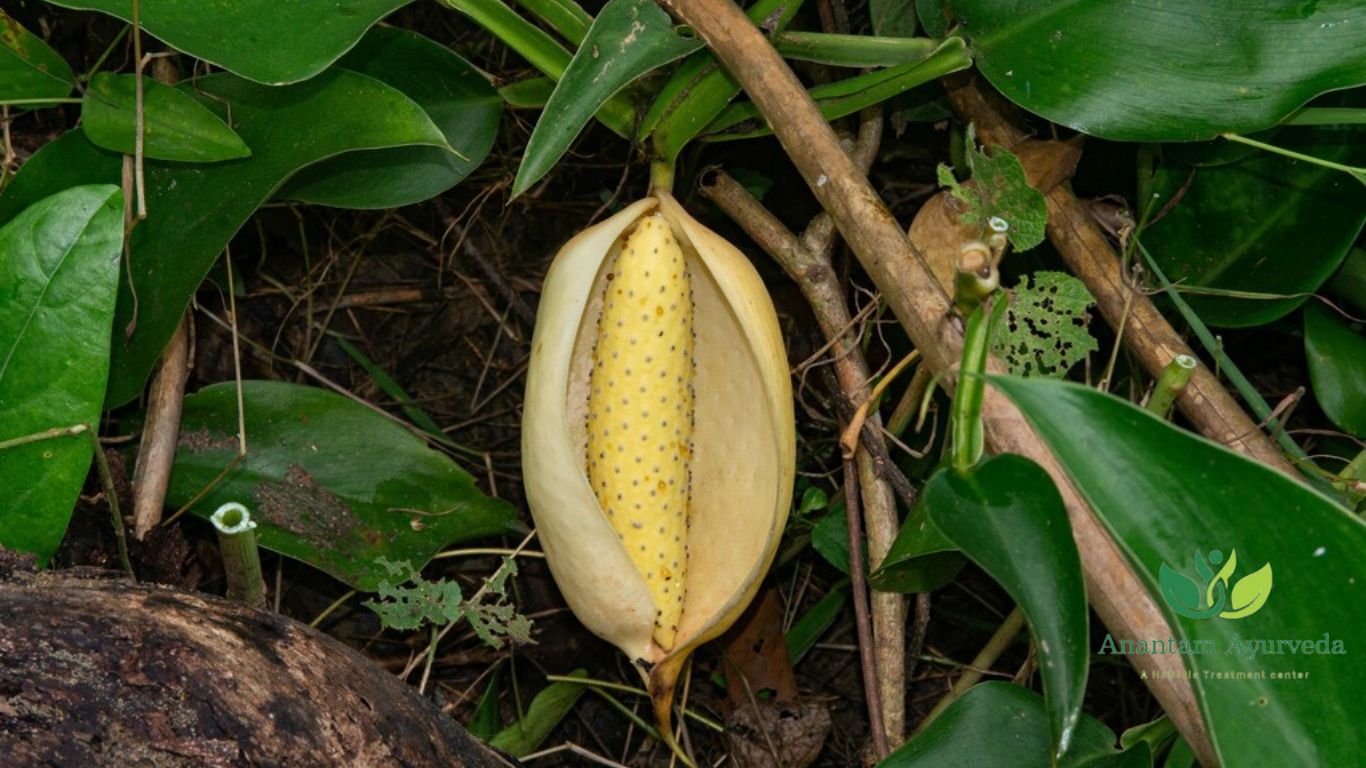
Frequently Asked Questions (FAQs) About GajaPippali (Scindapsus officinalis)
1. What is GajaPippali?
GajaPippali (Scindapsus officinalis) is a large-fruited variety of long pepper used in Ayurvedic medicine. The word “Gaja” means elephant, referring to the large size of the fruit compared to Piper longum. It is primarily used for its Kapha-Vata balancing properties, especially in treating respiratory and digestive ailments.
2. What are the key medicinal properties of GajaPippali?
-
Rasa (Taste): Katu (Pungent)
-
Guna (Qualities): Laghu (Light), Rooksha (Dry), Teekshna (Sharp)
-
Veerya (Potency): Ushna (Hot)
-
Vipaka (Post-digestive taste): Katu
-
Action (Karma): Kapha-Vata shamak, Deepana (digestive stimulant), and Krimighna (anti-parasitic)
3. What are the classical uses of GajaPippali in Ayurveda?
GajaPippali is traditionally used for:
-
Respiratory conditions: Asthma, bronchitis, cough, sinusitis
-
Digestive issues: Indigestion, anorexia, flatulence
-
Infectious disorders: Worm infestation, diarrhea
-
Rejuvenation: Added to formulations to enhance vitality and immunity
4. What are some classical formulations that include GajaPippali?
Notable Ayurvedic formulations include:
-
Agastya Haritaki Avaleha
-
Gajapippalyadi Churna
-
Vyaghri Haritaki Avaleha
-
Pippalyadi Ghrita
-
Shwasakuthara Rasa
These are used for respiratory care, digestive improvement, and detoxification.
5. How is GajaPippali administered?
-
Powder (Churna): 2–5 grams, typically with honey or warm water
-
Cold infusion (Hima): 5–10 ml
-
Paste: Applied externally with other herbs for joint pain and swelling
-
Combined use: Often mixed with herbs like Shatavari, Ashwagandha, and Vidanga
6. Are there any scientific studies supporting the benefits of GajaPippali?
Yes. Modern research has confirmed:
-
Anti-inflammatory effects (2014 study)
-
Antimicrobial activity (2015 study)
-
Hepatoprotective potential (2022 study)
-
Presence of bioactive compounds like Scindapsin A & B, along with flavonoids and sugars
7. Are there any side effects or precautions for using GajaPippali?
Yes. People with hyperacidity or gastric ulcers should avoid or limit use, as it has a hot potency which may aggravate Pitta. Always consult a qualified Ayurvedic physician before long-term or high-dose usage.
8. Is GajaPippali the same as regular Pippali (Piper longum)?
No. Although both are part of the long pepper family and used similarly, GajaPippali is botanically different and comes from Scindapsus officinalis, not Piper longum. Its fruit is larger and more potent in certain traditional preparations.
9. Can GajaPippali be used for children?
In mild doses, under professional supervision, GajaPippali can be used for childhood respiratory and digestive issues, especially when administered in the form of cold infusion with honey.
10. Where is GajaPippali commonly found in India?
GajaPippali grows in the temperate and tropical regions of India, especially in Assam, Bengal, the Himalayan foothills, and parts of Kerala. It is a climbing plant with leathery ovate leaves and a spadix of densely arranged yellowish flowers.
You can also read about Sarpagandha (Rauvolfia serpentina): Is It Good for Hypertension?
